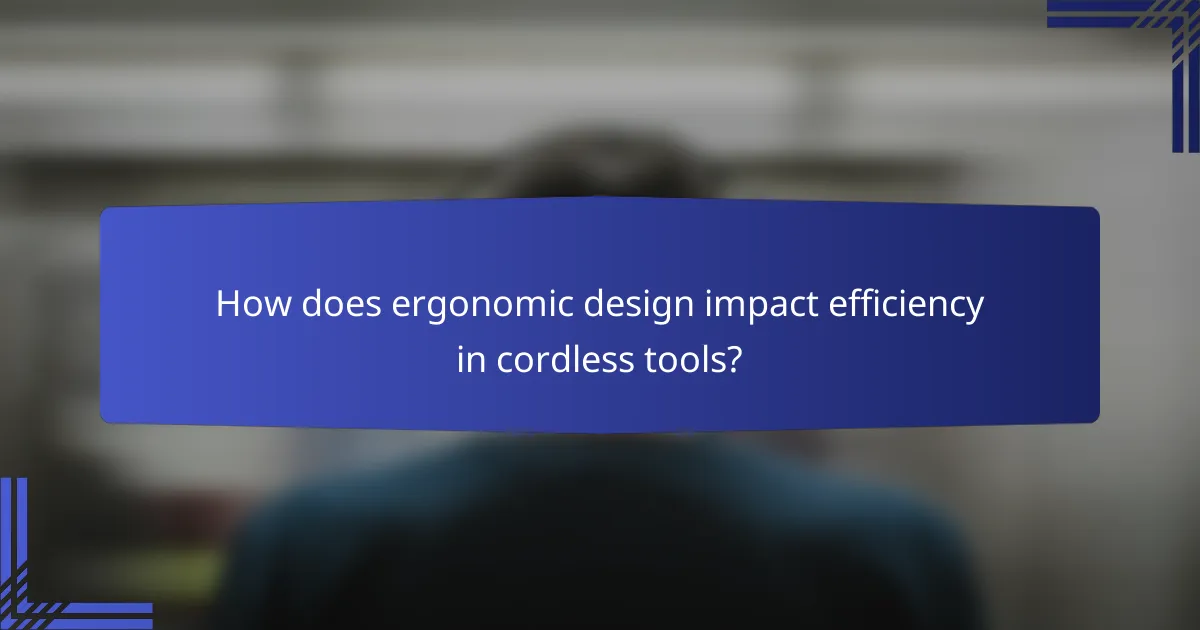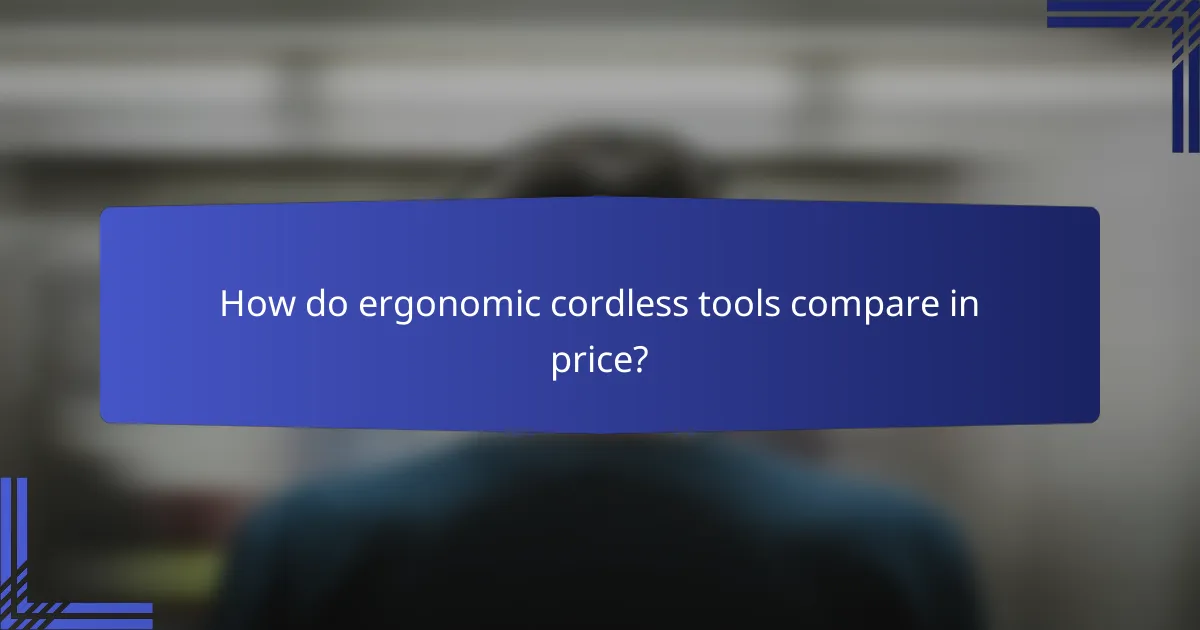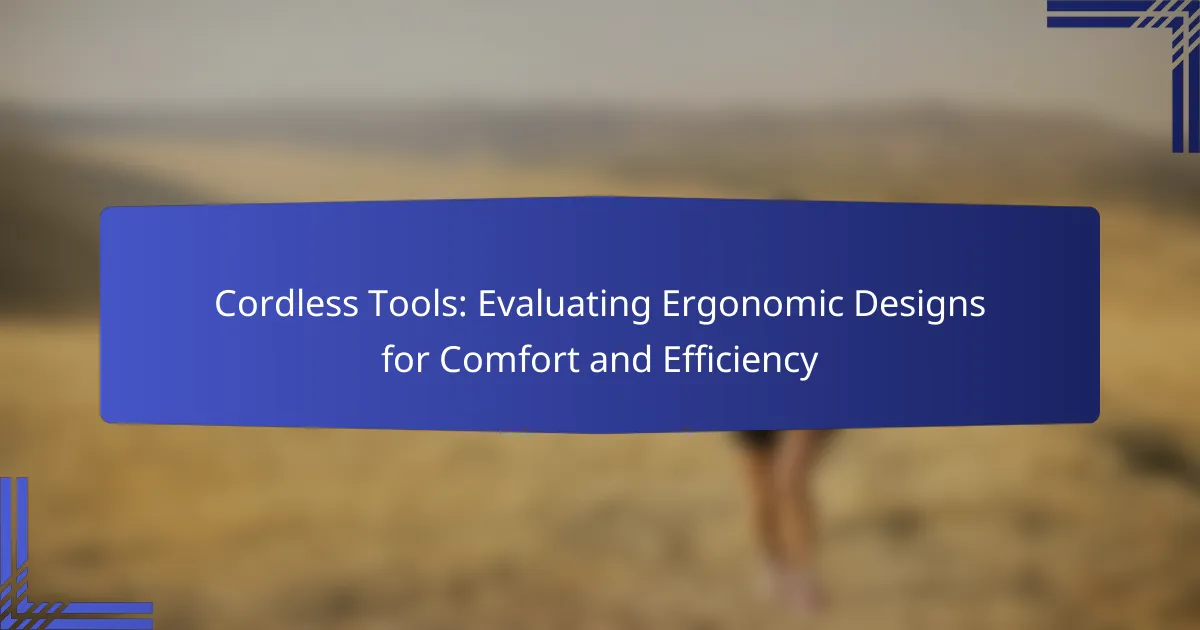Evaluating ergonomic designs in cordless tools is essential for enhancing user comfort and efficiency. By focusing on factors such as grip design, weight distribution, and vibration control, these tools minimize fatigue and strain during extended use. A well-designed ergonomic tool not only promotes a natural grip but also optimizes handling characteristics for a more enjoyable experience.

How do ergonomic designs enhance comfort in cordless tools?
Ergonomic designs in cordless tools significantly enhance comfort by reducing strain on the user during operation. These designs focus on optimizing the tool’s shape, weight, and handling characteristics to promote a natural grip and minimize fatigue.
Improved grip design
Improved grip design is crucial for comfort in cordless tools, as it allows for a more secure and natural hold. Features such as contoured handles and soft-touch materials can help distribute pressure evenly across the hand, reducing discomfort during prolonged use.
When selecting a cordless tool, look for grips that fit your hand size and shape. Tools with textured surfaces can also enhance grip security, especially in wet or slippery conditions.
Weight distribution
Weight distribution plays a vital role in the overall comfort of cordless tools. Tools that are well-balanced reduce the effort needed to control them, allowing for extended use without excessive fatigue. A tool that feels heavy at the front can lead to strain on the wrist and arm.
Consider tools with a central weight distribution, which can help maintain control and reduce the risk of injury. Testing the tool in hand before purchase can provide insight into its balance and comfort level.
Vibration reduction
Vibration reduction is essential for minimizing discomfort and potential long-term injuries when using cordless tools. Tools equipped with vibration-dampening technology can significantly lower the amount of vibration transmitted to the user’s hands and arms, enhancing comfort during operation.
Look for tools that meet established vibration standards, such as those set by the American National Standards Institute (ANSI). Tools with lower vibration ratings are generally more comfortable for extended use, making them a better choice for frequent tasks.

Which cordless tools offer the best ergonomic features?
Several cordless tools stand out for their ergonomic designs, which enhance user comfort and efficiency. Key features to consider include grip design, weight distribution, and vibration control, all of which contribute to reduced fatigue during extended use.
DeWalt DCD791D2
The DeWalt DCD791D2 is known for its lightweight design and well-placed grip, making it comfortable for prolonged tasks. Its compact size allows for easy maneuverability in tight spaces, while the rubber overmolded handle provides a secure grip, reducing hand strain.
This model also features a brushless motor that enhances efficiency and runtime, allowing users to work longer without needing frequent breaks. The balance of the tool helps minimize wrist fatigue, making it a solid choice for both professionals and DIY enthusiasts.
Milwaukee M18 Fuel
Milwaukee’s M18 Fuel series incorporates advanced ergonomics with a focus on user comfort. The tool’s design includes a lightweight frame and an optimized handle that fits comfortably in the hand, which is essential for reducing fatigue during heavy-duty applications.
Additionally, the M18 Fuel features a high-performance motor that delivers more power while maintaining a manageable weight. Users appreciate the integrated vibration dampening technology, which further enhances comfort during extended use, making it ideal for construction and renovation projects.
Makita XFD131
The Makita XFD131 is designed with user ergonomics in mind, featuring a rubberized grip that absorbs shock and provides a comfortable hold. Its lightweight construction allows for easy handling, making it suitable for various tasks without causing excessive strain on the user.
This model also includes a two-speed transmission, allowing users to adjust power settings based on the task at hand. The well-balanced design helps maintain control and precision, which is particularly beneficial for intricate work, ensuring both comfort and efficiency during operation.

What are the key factors to consider when evaluating ergonomic cordless tools?
When evaluating ergonomic cordless tools, key factors include handle shape, weight, and control layout. These elements significantly influence user comfort and efficiency during prolonged use.
Handle shape
The handle shape of a cordless tool directly affects grip comfort and control. A well-designed handle should fit the natural contours of the hand, reducing strain and fatigue. Look for handles that are contoured or have rubberized grips for better traction and comfort.
Consider the size of the handle as well; it should accommodate various hand sizes without causing discomfort. Testing different shapes can help identify which design feels most comfortable during extended tasks.
Weight
The weight of a cordless tool plays a crucial role in its usability, especially for tasks requiring overhead or extended use. Lighter tools are generally easier to handle and reduce fatigue, while heavier models may offer more power but can be cumbersome.
As a guideline, aim for tools that weigh under 2.5 kg for optimal balance between power and ease of use. Always test the tool in hand to assess how the weight feels during operation.
Control layout
The control layout of a cordless tool should allow for easy access to switches and settings without straining the hand. Controls that are intuitively placed can enhance efficiency and safety, allowing for quick adjustments while working.
Look for tools with controls that require minimal finger movement and are clearly labeled. Testing the tool’s controls before purchase can help ensure they meet your ergonomic needs and preferences.

How does ergonomic design impact efficiency in cordless tools?
Ergonomic design significantly enhances efficiency in cordless tools by reducing user fatigue and improving comfort during prolonged use. Tools that fit well in the hand and minimize strain allow for longer working periods and better control, ultimately leading to higher performance.
Reduced fatigue
Ergonomic cordless tools are designed to minimize physical strain, which can lead to reduced fatigue during tasks. Features such as contoured grips and balanced weight distribution help users maintain a comfortable posture, allowing them to work for extended periods without discomfort.
For instance, tools with soft rubber grips can absorb vibrations, which decreases hand fatigue. Choosing tools that are lightweight yet sturdy can also help in reducing overall fatigue, making it easier to complete tasks efficiently.
Increased precision
Ergonomic designs enhance precision in cordless tools by providing better control and stability. When tools fit comfortably in the hand, users can maneuver them with greater accuracy, which is crucial for detailed work such as carpentry or electrical installations.
Additionally, features like adjustable handles or trigger sensitivity can further improve precision. For example, a tool that allows for variable speed control enables users to adjust their approach based on the task, enhancing overall accuracy.
Enhanced productivity
With reduced fatigue and increased precision, ergonomic cordless tools lead to enhanced productivity. Users can complete tasks more quickly and with fewer errors, which is particularly beneficial in professional settings where time and quality are critical.
To maximize productivity, it’s advisable to select tools that are specifically designed for the intended task. For example, a drill with an ergonomic design tailored for overhead work can significantly speed up the process compared to a standard model. Regular maintenance and ensuring that tools are in good working condition also contribute to sustained productivity levels.

What are the benefits of using ergonomic cordless tools in home improvement projects?
Ergonomic cordless tools enhance comfort and efficiency during home improvement tasks by reducing fatigue and improving handling. These tools are designed to fit the natural contours of the hand, allowing for longer usage without discomfort.
Comfort during extended use
Using ergonomic cordless tools significantly increases comfort during prolonged tasks. Features such as padded grips and balanced weight distribution help minimize pressure points on the hands and wrists. This design allows users to work for longer periods without experiencing the typical discomfort associated with standard tools.
For instance, a well-designed cordless drill with an ergonomic handle can make drilling through materials like wood or drywall much more pleasant, reducing the need for frequent breaks.
Less strain on joints
Ergonomic cordless tools are specifically engineered to reduce strain on joints, particularly in the hands, wrists, and elbows. By promoting a more natural hand position, these tools help prevent repetitive strain injuries that can occur with traditional designs. This is especially beneficial for individuals who engage in frequent home improvement projects.
For example, using a lightweight, ergonomically shaped saw can lessen the impact on the elbow joint, making it easier to perform tasks like cutting without discomfort.
Improved task performance
With ergonomic cordless tools, users often experience enhanced task performance due to better control and reduced fatigue. The design elements that promote comfort also contribute to precision, allowing for more accurate cuts, drills, or fastenings. This can lead to higher-quality results in home improvement projects.
Moreover, tools that fit well in the hand can improve grip strength and stability, making it easier to handle challenging tasks, such as overhead drilling or intricate assembly work.

How do ergonomic cordless tools compare in price?
Ergonomic cordless tools generally range from moderately priced to premium, depending on design features and brand reputation. While basic models may start around $50, high-end ergonomic options can exceed $300, reflecting their advanced comfort and efficiency benefits.
Factors influencing the price of ergonomic cordless tools
Several factors impact the pricing of ergonomic cordless tools, including brand, materials, and design complexity. Tools from well-known brands often carry a premium due to their reputation for quality and durability. Additionally, tools made with advanced materials or featuring innovative ergonomic designs may also be priced higher.
Another consideration is the tool’s intended use. Professional-grade tools designed for heavy-duty applications typically cost more than those aimed at casual users or DIY enthusiasts. Understanding your specific needs can help you choose a tool that offers the best value for your budget.
Price ranges for different types of ergonomic cordless tools
Ergonomic cordless drills typically range from $60 to $250, depending on features like battery life and torque settings. Cordless saws can vary widely, with prices from around $70 for basic models to over $300 for high-performance options.
For other tools, such as impact drivers and nailers, expect to pay between $80 and $250. It’s advisable to compare features and read reviews to ensure you are getting a tool that balances comfort and efficiency within your price range.
Where to find the best deals on ergonomic cordless tools
To find the best deals on ergonomic cordless tools, consider shopping at major home improvement retailers, online marketplaces, and manufacturer websites. Seasonal sales, clearance events, and promotions can offer significant savings.
Additionally, signing up for newsletters or loyalty programs can provide access to exclusive discounts. Always compare prices across different platforms to ensure you are getting the best deal possible.
